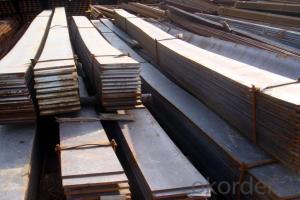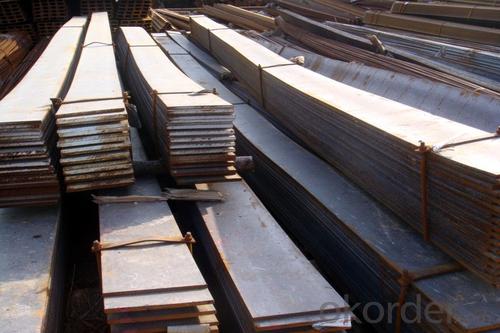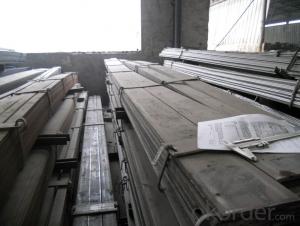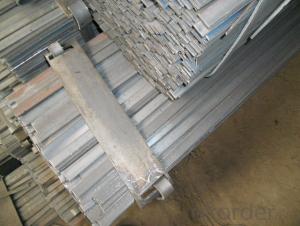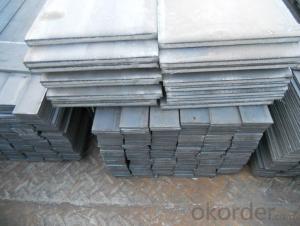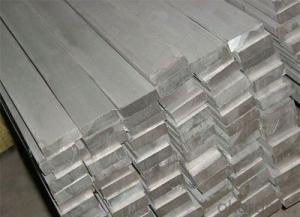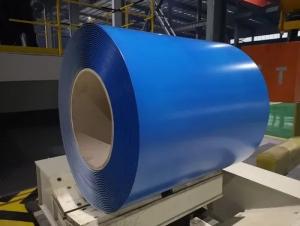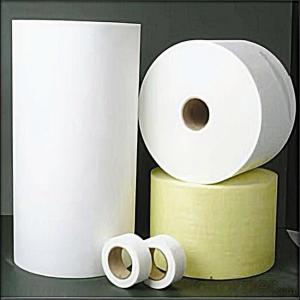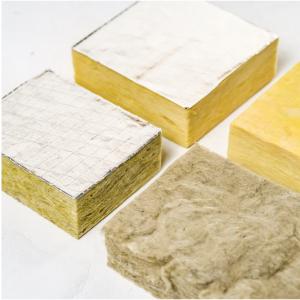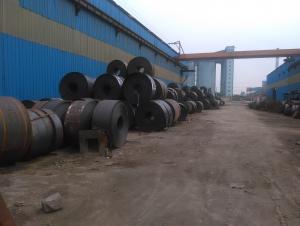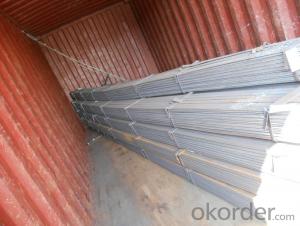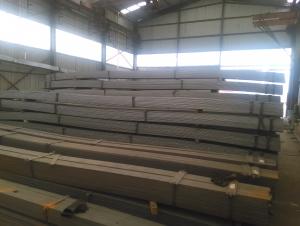Rolled Steel Flats for Automobile Special Steel Flat Bar
- Loading Port:
- China main port
- Payment Terms:
- TT or LC
- Min Order Qty:
- 50 m.t.
- Supply Capability:
- 5000 m.t./month
OKorder Service Pledge
OKorder Financial Service
You Might Also Like
Commodity: Carbon Steel Flat Bar
Standard: GB, JIS, ASTM,
Material: Q235, SS400 or Equivalent
Origin place: China
Thickness: 3mm-30mm
Width:20mm-200mm
Length: Max 12m
Certification: SGS/BV
Chemical composition
Alloy No | Grade | Element(%) | ||||
C | Mn | S | P | Si | ||
Q235 | B | 0.12—0.20 | 0.3—0.7 | ≤0.045 | ≤0.045 | ≤0.3 |
Physical properties
Alloy No | Grade | Yielding strength point(Mpa) | Tensile strength (Mpa) | Elongation after fracture(%) | ||||||
Thickness (mm) | Thickness (mm) | |||||||||
≤16 | >16--40 | >40--60 | >60--100 | ≤16 | >16--40 | >40--60 | >60--100 | |||
≥ | ≥ | |||||||||
Q235 | B | 235 | 225 | 215 | 205 | 375--500 | 26 | 25 | 24 | 23 |
Usage/Applications of Flat Bar
Widely used for construction;
Machinery manufacturing;
Iron tower steel structure;
Shipbuilding; Steel grating;
Staircase;
Bridge;
Viaduct;
Railway spare parts;
Boilers making etc.
Packaging & Delivery
Packaging Details: The Steel Flat Bars are packed in bundles and loaded in 20 feet/40 feet container, or shipped by bulk cargo ,also we can do as customer's requirements.
Delivery Details:30~45 days upon the receipt of buyer payment by T.T. or L/C.
Production Flow
The Carbon Steel Flat Bar is made through three processes:
1.Feeding the material: Feeding the row material (the steel plate) to Slitting Line.
2.Slitting:The steel plate would be slitted into expected width by lengthways cutter.
3. Leveled and cutting: The plat bar would be ground into level by the grinder and then cut into required length.
FAQ:
Q1: Why buy Materials & Equipment from OKorder.com?
A1: All products offered byOKorder.com are carefully selected from China's most reliable manufacturing enterprises. Through its ISO certifications, OKorder.com adheres to the highest standards and a commitment to supply chain safety and customer satisfaction.
Q3: How soon can we receive the product after purchase?
A3: Within three days of placing an order, we will begin production. The specific shipping date is dependent upon international and government factors, but is typically 7 to 10 workdays.
Q4: What makes stainless steel stainless?
A4: Stainless steel must contain at least 10.5 % chromium. It is this element that reacts with the oxygen in the air to form a complex chrome-oxide surface layer that is invisible but strong enough to prevent further oxygen from "staining" (rusting) the surface. Higher levels of chromium and the addition of other alloying elements such as nickel and molybdenum enhance this surface layer and improve the corrosion resistance of the stainless material.


- Q:Can steel flat bars be used for making brackets or brackets?
- Yes, steel flat bars can definitely be used for making brackets or brackets. Steel is a strong and durable material, making it suitable for various applications, including bracket manufacturing. Steel flat bars can be easily shaped, cut, and welded to create brackets of different sizes and shapes. They provide stability and support, making them ideal for holding objects or providing structural reinforcement. Additionally, steel's corrosion resistance makes it a reliable choice for brackets that may be exposed to moisture or other harsh conditions.
- Q:What are the safety precautions when handling steel flat bars?
- When handling steel flat bars, there are several safety precautions that should be taken to ensure the well-being of individuals involved. 1. Personal Protective Equipment (PPE): It is crucial to wear appropriate PPE to minimize the risk of injuries. This includes gloves, safety glasses, and steel-toed boots to protect yourself from potential cuts, eye injuries, and foot injuries. 2. Lifting Techniques: Steel flat bars can be heavy and bulky, so it is important to use proper lifting techniques to avoid strain or back injuries. Lift with your legs, not your back, and always ask for assistance if the weight is too heavy to handle alone. 3. Storage and Stacking: When storing or stacking steel flat bars, ensure they are properly secured to prevent them from falling or toppling over. Use appropriate storage racks or shelves to keep them organized and avoid any potential hazards. 4. Sharp Edges: Steel flat bars often have sharp edges, so it is essential to be cautious and handle them with care. Avoid dragging or sliding them across surfaces to prevent injuries. Additionally, rounding or deburring the edges can reduce the risk of cuts. 5. Fire Safety: Steel is highly flammable, so it is important to keep the work area clear of any flammable materials and ensure the presence of fire extinguishers. Avoid using steel flat bars near open flames or other sources of ignition. 6. Proper Training: Adequate training and familiarity with handling steel flat bars are essential for safety. Educate yourself and others on the proper techniques and precautions to follow to minimize the potential risks. 7. Regular Maintenance: Inspect the steel flat bars regularly for any signs of damage, such as cracks or corrosion. Damaged bars should be replaced to avoid potential accidents. By implementing these safety precautions, individuals can effectively reduce the risks associated with handling steel flat bars and promote a safer work environment.
- Q:The distinction between flat steel and steel strip
- The first is to use cyanide cyanide salt, it is commonly referred to as the "cyanide", it is the metal surface while being carbon atoms and nitrogen in a chemical heat treatment process of saturated (cyanide containing carbon, nitrogen, assuming the metal is a, valence +n, cyanide formula a (CN) n).
- Q:How can copper clad steel ground electrode and galvanized flat steel be welded?
- Using hot fusion welding. It is welded firmly and will not corrode the weld because of electrochemical action.The common copper clad steel wire electrode is copper wire.
- Q:What are the different types of steel flat bars available in the market?
- There are several different types of steel flat bars available in the market, including mild steel flat bars, stainless steel flat bars, alloy steel flat bars, and carbon steel flat bars. Each type of flat bar has its own unique properties and characteristics, making them suitable for different applications and industries.
- Q:Are steel flat bars available in custom sizes?
- Indeed, custom-sized steel flat bars can be obtained. Although standard sizes of steel flat bars are readily available in the market, numerous suppliers and manufacturers provide the opportunity to personalize the dimensions of flat bars according to specific demands. This grants customers the ability to acquire steel flat bars that are perfectly suited for their particular project requirements, whether it entails a distinct length, width, or thickness. The customization of steel flat bar sizes guarantees an accurate fit and maximum efficiency for a wide range of applications, encompassing construction, manufacturing, and fabrication.
- Q:Can steel flat bars be anodized?
- No, steel flat bars cannot be anodized. Anodizing is a process primarily used on aluminum and its alloys to create a protective oxide layer on the surface. This process involves immersing the metal in an electrolyte solution and passing an electric current through it, causing oxygen ions to bond with the metal and form the protective layer. Steel, on the other hand, is mainly composed of iron and does not form the same type of oxide layer as aluminum during anodizing.
- Q:How do you prevent twisting of steel flat bars during welding?
- To avoid the twisting of steel flat bars during welding, there are several precautions that can be taken: 1. Proper preparation is essential. It is important to ensure that the flat bars are thoroughly cleaned and free from any contaminants such as oil, grease, or rust. A wire brush or grinder can be used to remove any impurities on the surface. 2. Securely clamp the flat bars before welding. Sturdy clamps or magnetic welding fixtures can be used to firmly hold the bars in place, preventing any movement or twisting during the welding process. 3. Prior to performing the full weld, temporary tack welds can be used to hold the flat bars together. This will help maintain their alignment and prevent twisting while the final weld is applied. 4. Adopt a strategic weld sequence that minimizes heat distortion and potential twisting. Instead of welding a continuous bead along the entire length of the flat bars, it is recommended to alternate between different sections or weld in short intervals, allowing each area to cool before continuing. 5. Control the heat input during welding by using the appropriate welding technique and adjusting the welding parameters. High heat levels can cause the steel to expand and contract, leading to twisting. Techniques such as pulse welding or reducing the amperage can help control heat input and minimize the risk of twisting. 6. For thicker or more susceptible steel flat bars, preheating the material before welding can help reduce the risk of twisting. Additionally, performing post-weld heat treatment can relieve residual stresses and prevent distortion. 7. Allow the welded flat bars to cool slowly and naturally after welding. Rapid cooling, such as through water quenching, can induce additional stresses and contribute to twisting. It is important to avoid abrupt temperature changes and provide sufficient time for the welded bars to cool down gradually. By implementing these preventive measures, the risk of twisting in steel flat bars during welding can be significantly reduced, ensuring a successful and distortion-free weld.
- Q:What are the common methods of surface cleaning for steel flat bars?
- Surface cleaning steel flat bars can be achieved through several common methods. These methods include: 1. Employing Mechanical Cleaning: Physical scrubbing using abrasive materials like wire brushes, sandpaper, or abrasive pads effectively removes dirt, rust, or other contaminants from the surface of steel flat bars. This method is suitable for light to moderate cleaning and can be done manually or with the assistance of power tools. 2. Utilizing Chemical Cleaning: The use of various cleaning agents or solvents dissolves and eliminates stubborn contaminants such as dirt, grease, oil, from the surface of steel flat bars. Alkaline or acidic solutions, degreasers, or specialized steel cleaners are commonly used cleaning agents. It is crucial to adhere to the manufacturer's instructions and safety guidelines when handling chemical cleaning agents. 3. Implementing Pickling: Pickling is a method typically employed to remove heavy rust or scale from the surface of steel flat bars. This method involves immersing the bars in an acidic solution, usually a mixture of hydrochloric acid and water, which effectively dissolves the rust or scale. After pickling, the bars are thoroughly rinsed to eliminate any remaining acid and then dried. 4. Utilizing Sandblasting: This method employs compressed air to propel fine abrasive particles, such as sand or steel grit, at high speeds onto the surface of steel flat bars. Sandblasting is highly effective for removing heavy rust, scale, or old paint coatings. Additionally, it creates a roughened surface that enhances adhesion for subsequent coatings or finishes. 5. Employing Electrochemical Cleaning: Electrochemical cleaning, also known as electrolysis or electrocleaning, utilizes an electric current to eliminate rust or other contaminants from the surface of steel flat bars. The bars are submerged in an electrolyte solution, and the electric current dissolves the rust, leaving a clean surface. This method is commonly used for delicate or intricate surfaces where mechanical methods may cause damage. Choosing the appropriate cleaning method is essential and should be based on the level of contamination, type of surface, and desired end result. It is crucial to follow proper safety procedures and wear personal protective equipment when conducting surface cleaning on steel flat bars.
- Q:How do steel flat bars perform in terms of thermal conductivity?
- Steel flat bars have a relatively high thermal conductivity compared to other materials. This means that they are quite efficient in conducting heat. When exposed to high temperatures, steel flat bars quickly absorb and distribute heat throughout their structure. Conversely, steel flat bars also dissipate heat efficiently, allowing them to cool down rapidly. This property makes steel flat bars suitable for various applications where thermal conductivity is important, such as in the construction industry, where they are commonly used in heat transfer systems, heat exchangers, and other thermal management applications.
1. Manufacturer Overview |
|
|---|---|
| Location | |
| Year Established | |
| Annual Output Value | |
| Main Markets | |
| Company Certifications | |
2. Manufacturer Certificates |
|
|---|---|
| a) Certification Name | |
| Range | |
| Reference | |
| Validity Period | |
3. Manufacturer Capability |
|
|---|---|
| a)Trade Capacity | |
| Nearest Port | |
| Export Percentage | |
| No.of Employees in Trade Department | |
| Language Spoken: | |
| b)Factory Information | |
| Factory Size: | |
| No. of Production Lines | |
| Contract Manufacturing | |
| Product Price Range | |
Send your message to us
Rolled Steel Flats for Automobile Special Steel Flat Bar
- Loading Port:
- China main port
- Payment Terms:
- TT or LC
- Min Order Qty:
- 50 m.t.
- Supply Capability:
- 5000 m.t./month
OKorder Service Pledge
OKorder Financial Service
Similar products
New products
Hot products
Hot Searches
Related keywords
